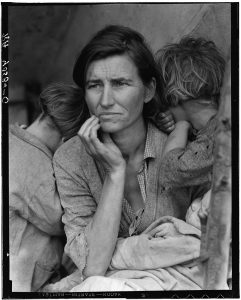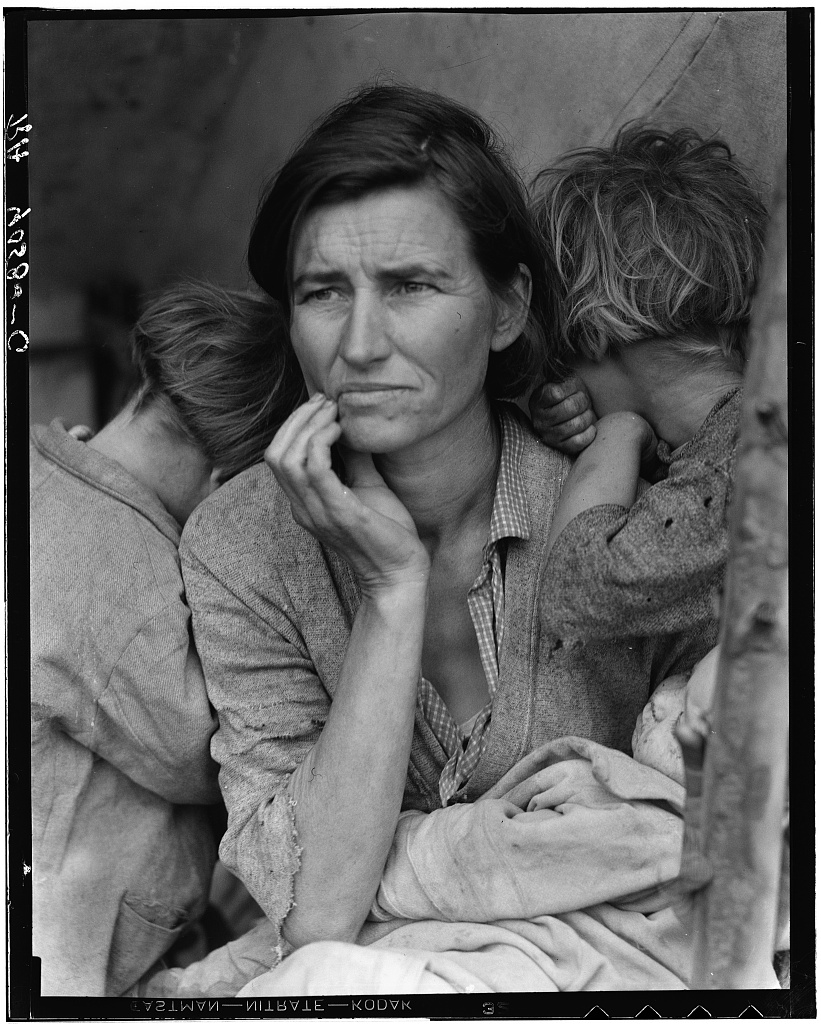
Image courtesy of Library of Congress
The image, “Destitute pea pickers in California. Mother of seven children. Age thirty-two. Nipomo, California,” was taken in 1936 by the American photographer Dorothea Lange. During the Great Depression, Lange and other photographers were assigned to work for the Farm Security Administration (FSA), an organization whose photographs studied the socioeconomic “relations of American agricultural labor.”[1] Lange captured photographs that detailed the everyday struggles of families working in agriculture from various backgrounds. This photograph of a mother with her children earned Lange fame yet caused the misinterpretation of her work. Lange’s photographs have been “decontextualized and universalized,” distancing them from their original meaning.[2] Lange took this image to capture a glimpse into the lives of migrant workers living in poverty and who faced unstable employment. These laborers moved around California depending on the season but were without work for extended periods.[3]
This image was taken during the Great Depression. Before the stock market crash in 1929, the American economy was in decline due to “overproduction and underconsumption.”[4] The effects of the struggling economy were also evident in agriculture. During the First World War, Europeans depended on American farms for goods, but there was no longer a demand for these commodities, and farm prices shrank.[5] In addition to the weakened economy, a drought known as the Dust Bowl ruined land in states crucial to the United States’ agriculture.[6] Following the Dust Bowl, “Many farmers and their families from the South and the Midwest headed toward California, where jobs were said to be plentiful.”[7] After arriving in California, the migrant mother, along with other migrant families, learned that the pea crop in Nipomo had been decimated by disastrous rains.[8] The title of the image includes the words “destitute” and “mother of seven children.” The author’s choice to include these words in the title reflects the mother’s desperation, which is conveyed through multiple elements in the image.
The experiences of migrant families in California can be connected with the Great Drought of 1930, a natural disaster that impacted the United States on a national level.[9] At the center of the photograph, the woman has her gaze fixed off to the side as she has a slight frown on her face. Her eyebrows are furrowed, and her hand is lightly placed on her face. Through her facial expression, gaze, and position, the mother appears pensive. In responding to the drought President Herbert Hoover helped establish the National Drought Relief Committee (NDRC) which included the Red Cross.[10] One of Hoover’s shortcomings in his relief efforts for the disaster was his high expectations for the Red Cross to provide sufficient aid to struggling Americans. An article published in The Journal of American History explains, “like other parts of the relief package, Red Cross aid was being offered in considerably smaller amounts than Hoover had expected.”[11] Following the Dust Bowl, for migrant families in California, assistance was urgently needed. However, attaining relief was complex. Relief in California was administered by two systems, “Through the State Emergency Relief Administration (SERA) and its successor organization the California State Relief Administration (SRA).”[12]
The two systems brought the risk that those needing aid could fail to qualify, “leaving them unsure of who to seek relief from or with no level of administration providing them assistance.”[13] In the image, both the mother and her children are wearing tattered clothing and the child to her left has unkempt hair and is visibly covered with dirt. In addition, there is a sleeping baby in the mother’s arms. Behind the family is a fabric tarp which is supported by a post to the right of the image. The unstable structure could be the only shelter for the mother and all seven of her children. Both efforts to provide financially struggling Americans with relief highlight some of the obstacles the United States faced during the Great Depression.
References
[1] Gordon, Linda. “Dorothea Lange: The Photographer as Agricultural Sociologist.” The Journal of American History 93, no. 3 (2006): 698.
[2] Ibid., 701.
[3] Ibid., 705.
[4] Shi, D. E. (2022). America: A Narrative History (Brief Twelfth Edition) (Volume 2) (12th ed.). New York, NY: W. W. Norton. 983.
[5] Ibid.
[6] Ibid., 990.
[7] Ibid.
[8] Hodgson, Jack. “Californians and Others: Children’s Health, Nutrition, and Welfare in Depression-Era Migrant Camps.” Journal of American Studies: JAS 57, no. 2 (May 1, 2023): 239.
[9] Hamilton, David E. “Herbert Hoover and the Great Drought of 1930.” The Journal of American History 68, no. 4 (1982): 851.
[10] Ibid., 854.
[11] Ibid., 859.
[12] James Leiby, “State Welfare Administration in California, 1930-1945,” Southern California Quarterly, 55, 3 (1973), 303–18, 308. Cited in Hodgson, Jack. “Californians and Others: Children’s Health, Nutrition, and Welfare in Depression-Era Migrant Camps.” Journal of American Studies: JAS 57, no. 2 (May 1, 2023): 237–238. doi:10.1017/S0021875822000287.
[13] Hodgson, Jack. “Californians and Others: Children’s Health, Nutrition, and Welfare in Depression-Era Migrant Camps.” Journal of American Studies: JAS 57, no. 2 (May 1, 2023): 238. doi:10.1017/S0021875822000287.
